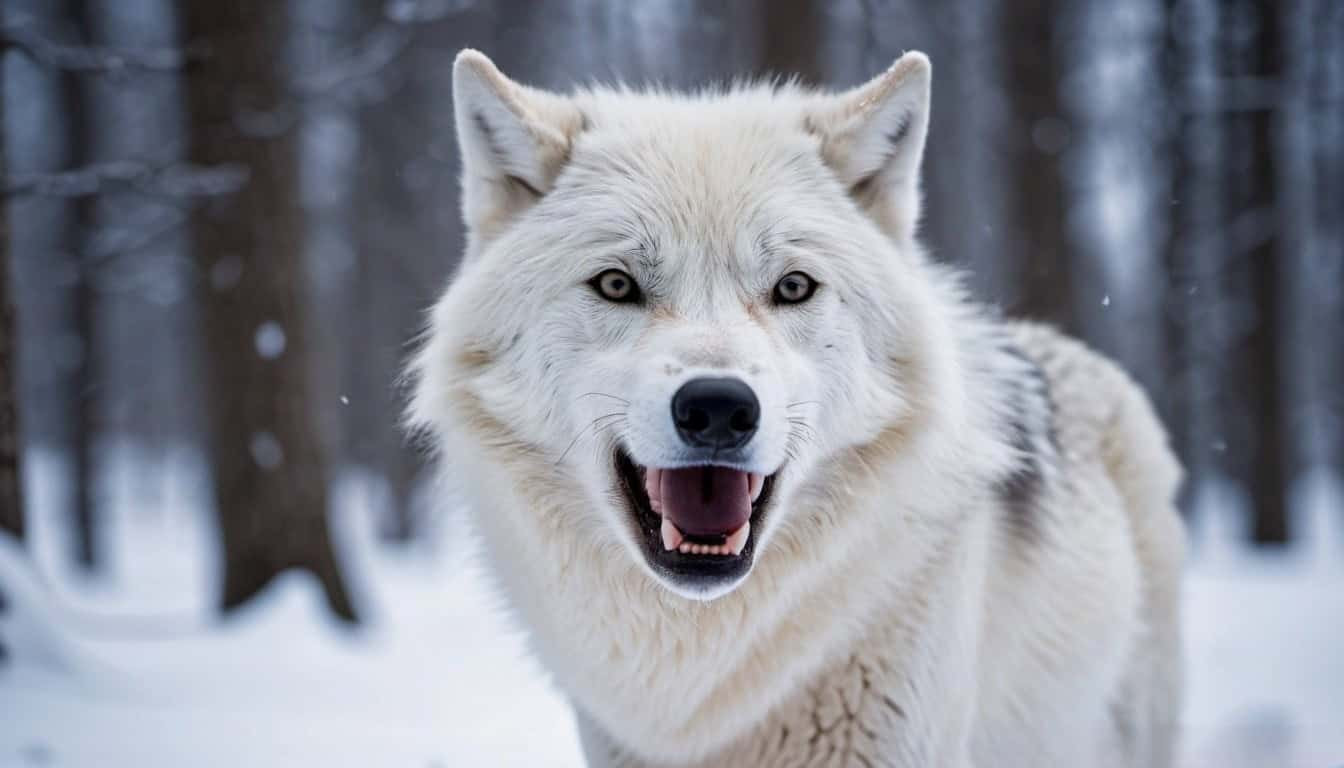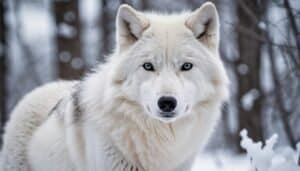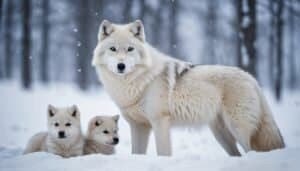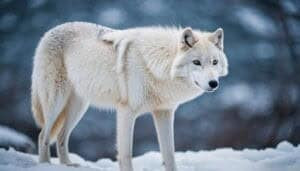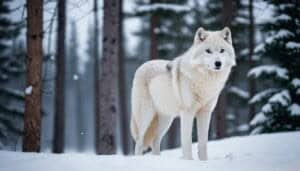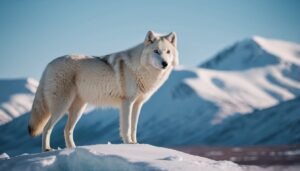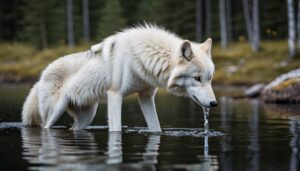Introduction
Arctic wolves, adapted to the extreme cold of the Arctic, have developed unique physiological and behavioral strategies to expel excess heat and maintain their body temperature
This article delves into the adaptations of Arctic wolves, comparing their thermoregulation mechanisms with other canids, and examines how environmental and seasonal changes impact their heat management strategies
Physiological and Behavioral Adaptations for Heat Management
Arctic wolves, inhabiting one of the coldest regions on Earth, face the unique challenge of expelling excess heat in their frigid environment
Despite the freezing temperatures, these wolves can generate substantial body heat through physical activity and metabolic processes. To maintain their body temperature within a safe range, Arctic wolves have evolved a combination of physiological and behavioral adaptations
This section explores these adaptations, focusing on their fur, blood vessels, respiratory system, and behavioral strategies like panting, seeking shade, and adjusting activity patterns
The Role of Fur in Thermoregulation
The fur of an Arctic wolf plays a crucial role in both insulation and heat management
Their double-layered coat consists of a dense undercoat and a longer, water-resistant outer layer. While this fur is primarily designed to retain heat and protect against cold, it also allows for effective heat dissipation
During warmer periods or intense physical activity, the wolf’s fur helps manage heat by facilitating evaporative cooling. As the wolf pants, moisture from their breath helps cool their body, and the fur aids in the release of this heat
Blood Vessel Adaptations
Arctic wolves have developed specialized blood vessels that aid in thermoregulation. The countercurrent heat exchange system in their limbs minimizes heat loss
Blood vessels in the legs and paws are arranged in such a way that warm arterial blood warms the cooler venous blood returning to the heart. This system helps maintain core body temperature by reducing heat loss from extremities
Additionally, during periods of high activity, blood flow to the skin can increase, allowing excess heat to dissipate through radiation and convection
Respiratory System Contributions
The respiratory system of Arctic wolves is integral to their heat expulsion mechanisms
When a wolf pants, it rapidly inhales and exhales air, which facilitates evaporative cooling. This process involves moisture from the respiratory tract evaporating, which in turn cools the blood in the surrounding capillaries. Panting increases with rising body temperature, effectively helping to lower it
Studies have shown that panting can increase evaporative heat loss significantly, enabling the wolf to maintain a stable internal temperature even during vigorous activity (Smith, 2021)
Panting and Its Effectiveness
Panting is a primary method for Arctic wolves to expel excess heat. Unlike humans, who rely on sweating, wolves and other canids use panting as their main cooling mechanism
When a wolf pants, it increases the airflow over moist surfaces in the mouth and upper respiratory tract, which promotes evaporative cooling. This method is highly efficient; a panting wolf can lose significant amounts of heat, even in the cold Arctic environment
Research indicates that panting can account for a major portion of a wolf’s heat loss, particularly after intense physical exertion (Johnson & Parker, 2020)
Shade Seeking and Resting
Behavioral adaptations are also crucial for Arctic wolves in managing their body temperature
During the warmest parts of the day, wolves often seek shade or rest in cooler, sheltered areas to avoid overheating. This behavior is common among many animals living in extreme environments. By minimizing activity during peak temperatures and resting in shaded areas, Arctic wolves can prevent excessive heat buildup and conserve energy
Activity Patterns and Timing
Arctic wolves also adjust their activity patterns and timing to regulate their body temperature effectively. They tend to be more active during the cooler parts of the day, such as early morning and late evening
This behavior helps them avoid the heat generated by physical exertion during the warmer midday hours. Additionally, wolves may alter their hunting and traveling schedules based on temperature fluctuations, ensuring they remain within a comfortable thermal range
Comparative Analysis with Other Canids
Arctic wolves share many physiological and behavioral traits with other members of the canid family. However, living in one of the harshest climates on Earth, they have evolved unique adaptations to handle both extreme cold and the need to expel excess heat
In this section, we will compare and contrast the heat regulation mechanisms of Arctic wolves with those of other canids, highlighting both the differences and similarities in their thermoregulation strategies
Differences in Heat Regulation
One of the primary differences in heat regulation between Arctic wolves and other canids, such as domestic dogs or desert-dwelling foxes, lies in their fur. Arctic wolves possess a thick double-layered coat designed to insulate against the extreme cold
This fur is not only effective for retaining heat but also for managing it. In contrast, canids like the Fennec fox, which inhabit hot desert environments, have much shorter and lighter fur, optimized for minimal heat retention and maximum dissipation
Another significant difference is the behavioral adaptations specific to their environments. Arctic wolves, for instance, have developed the habit of seeking shade or resting during warmer periods, despite the overall cold climate. This contrasts with canids in warmer climates, such as African wild dogs, which dig burrows to escape the heat and reduce body temperature
Blood vessel adaptations also vary significantly. Arctic wolves have a countercurrent heat exchange system that minimizes heat loss through their extremities, a feature less pronounced in canids living in moderate or hot climates where retaining body heat is not as critical
Similarities in Thermoregulation
Despite the differences, Arctic wolves share several thermoregulation strategies with other canids
Panting is a universal cooling method among canids, used effectively by Arctic wolves, domestic dogs, coyotes, and others. This process involves rapid breathing, which increases airflow over moist surfaces in the respiratory tract, facilitating evaporative cooling. It’s an efficient mechanism to manage heat across different climates
The circulatory system also shows similarities. Like Arctic wolves, many canids have developed ways to increase blood flow to the skin to dissipate heat
This is evident in domestic dogs, which can dilate blood vessels in their skin to increase heat loss. Additionally, both Arctic wolves and other canids use their ears to regulate temperature. For instance, domestic dogs and Arctic wolves can increase blood flow to their ears, which helps expel excess heat due to the thinner skin and higher surface area-to-volume ratio
Behavioral adaptations to regulate temperature are another commonality. Most canids, regardless of habitat, exhibit behaviors such as seeking shade, altering activity levels based on temperature, and resting during the hottest parts of the day to avoid overheating
These behaviors are vital for conserving energy and maintaining a stable internal temperature
Environmental and Seasonal Influences
The Arctic environment presents unique challenges to the thermoregulation of Arctic wolves. Their ability to manage body heat effectively is influenced by a range of environmental factors and seasonal changes
This section examines how the habitat and seasonal variations impact the heat management strategies of Arctic wolves
Impact of Habitat on Heat Management
Arctic wolves inhabit regions with extreme weather conditions, characterized by freezing temperatures, ice, and snow. These environmental factors significantly influence their thermoregulation strategies
The vast, open landscapes of the Arctic mean that shade and shelter are limited, prompting wolves to seek out natural features such as rocks, caves, or vegetation to escape the heat when necessary
The presence of permafrost and snow also affects how Arctic wolves regulate their body temperature. Snow provides a natural cooling surface, and wolves often lie on the snow to dissipate excess body heat
Additionally, the reflective properties of snow can impact their heat management, as the bright, reflective surface can increase solar radiation exposure during the day
Seasonal Variations in Thermoregulation
Seasonal changes in the Arctic are extreme, with long, harsh winters and relatively short, cool summers. These seasonal variations have a significant impact on the thermoregulation strategies of Arctic wolves
During the winter months, the primary challenge is retaining body heat to survive the frigid temperatures. The thick double-layered fur of Arctic wolves is crucial during this period, providing excellent insulation
In contrast, the summer months, although short, bring milder temperatures that can still pose a risk of overheating. During this time, Arctic wolves must effectively expel excess heat to avoid hyperthermia
Panting becomes more frequent, and the wolves increase their use of behaviors such as seeking shade and resting during the warmest parts of the day. The ability to shed part of their winter coat also aids in adapting to the seasonal temperature rise
Additionally, seasonal variations affect the prey availability and hunting patterns of Arctic wolves. In the winter, when prey is scarcer and more energy is required to hunt, maintaining body heat is more critical. Conversely, during the summer, with more abundant food sources, the focus shifts to managing excess heat generated from increased activity levels
Moreover, the long daylight hours during the Arctic summer lead to extended periods of activity, which requires efficient heat management to sustain. Arctic wolves adjust their activity patterns to avoid the midday heat, often hunting during the cooler hours of the morning and evening
Conclusion
Arctic wolves have developed a sophisticated array of physiological and behavioral adaptations to manage excess heat in their frigid habitat. Their double-layered fur, specialized blood vessels, and efficient respiratory system work in harmony with behavioral strategies such as panting, seeking shade, and adjusting activity patterns
These adaptations allow them to thrive in the extreme conditions of the Arctic, showcasing their remarkable resilience and adaptability. Through a comparative analysis with other canids, we gain a deeper understanding of the unique and shared strategies for thermoregulation within this fascinating family of animals
The interplay between their environment, seasonal changes, and heat management mechanisms highlights the intricate balance Arctic wolves maintain to survive and flourish in their icy domain
